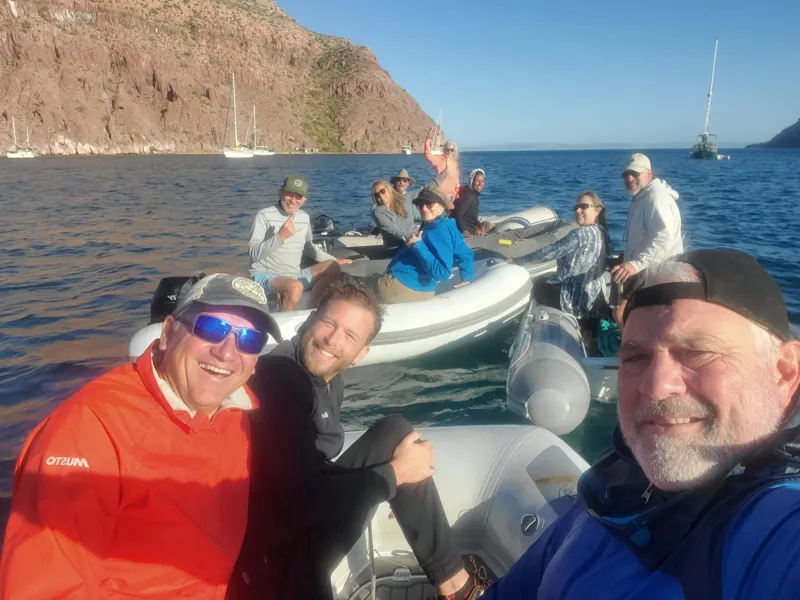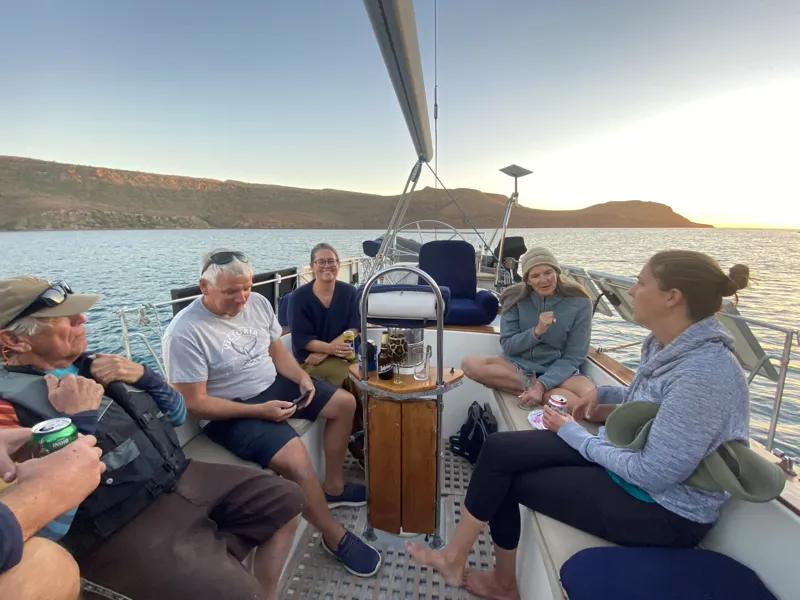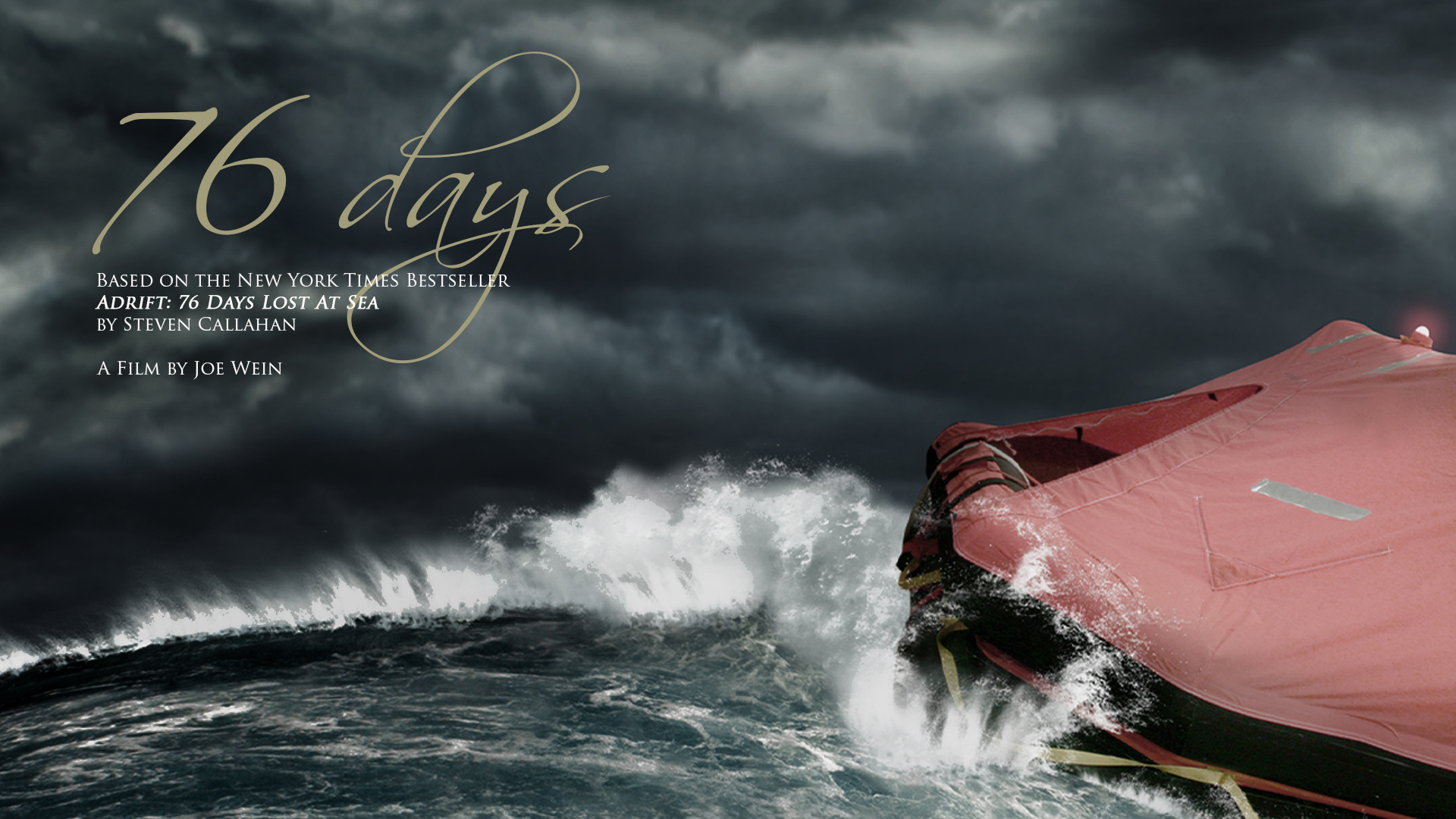
Alamedans Mingle With Global Cruising Community in Caleta Partida
Following the Baja Ha-Ha each year, boats scatter to cruise the Sea of Cortez and the mainland. Heidi Stagg catches us up on some of the participants and Alameda sailors in Caleta Partida.
What started as a simple meet-up of two liveaboard couples on sailboats in the Sea of Cortez became an amazing gathering of 11 boats, 24 people and three dogs over four days anchored in Caleta Partida, a cove that divides Espiritu Santo and Isla Partida in Baja California Sur, Mexico.

Aaron and Heidi Stagg on Sonho, a Tayana Vancouver 42, and Hugh and Lynn Creasy on Happy, their Moody 45, had sailed separately to La Paz. Heidi and Hugh had been friends in the 1980s, living in Alameda and sailing with their families on San Francisco Bay. They reconnected in Marina Village Yacht Harbor when Happy and her crew made their way down the coast from their homeport of Seattle, WA, in summer 2022. Sonho set off to cruise in fall 2022, and Happy turned left out the Golden Gate in 2023.
As Heidi chatted with fellow dockmates in Marina de La Paz about the planned cruise to the nearby islands, the fleet began to grow. Three boats, also with Alameda connections and now calling La Paz their homeport, joined the fleet: Henri and Perla on Caracolita, a Westsail 32, Jim, Rob, Adam and Naailah on AudreyAnna Hope, a Catalina 42, and Lucy and John on Sukha, a Bristol 40. Henri worked for KPIX and lived on Caracolita at Fortman Marina before retiring and sailing south. Rob berths his Gulfstar 44 at Oakland Yacht Club and crewed on AudreyAnna Hope in the recent Ha-Ha. Lucy bought Sukha (formerly named Mary Ellen and berthed at MVYH) in Alameda and was part of the 2021 Ha-Ha. Heidi crewed with Lucy from Cabo San Lucas to Bahia de los Frailes and Bahia de los Muertos after the Ha-Ha.

Also cruising from La Paz were Kevin, Vicky, Paloma and Rommel on Dos Peces, a Bayliner 47, who made the trek from Seward, AK, in 2021, and the Ha-Ha Assistant Poobah, Patsy, singlehanding as usual on Talion, a Gulfstar 50, who has called La Paz home for over 10 years.
Happy made friends with four boats anchored in the cove and they joined the festivities: Jeroen and Jeanette from Amsterdam on Fidelis, an Amel 54, Ralf and Wiebke from Hamburg on Flora, a Hallberg-Rassy 43, Mark on Prole, a Colin Archer-design 32-ft boat he built in Bellingham, WA, and Alex and Paige from Seattle, WA, on Chandelle a Morgan-designed 45-ft one-off.

Caleta Partida is a well-protected, large moorage located 12 miles from La Paz with gorgeous turquoise blue water and very shallow shoals. Boats anchor along the edge of the shoal in 12-20 feet of water in good-holding white sand, or deeper in the bay with depths up to 100 ft. The islands were formed by volcanic activity eons ago and provide shade and a breathtaking view of flora and fauna. Small rock formations are visible on shore at low tide, and the beaches are a shell-seeker and bone collector’s dream.
At high tide, dinghies can maneuver around a spit and access the east side of the islands to view ancient drawings inside caves, and tiny, pristine beaches. Care needs to be taken to get back before the low tide or you’ll be dragging your dinghy a few hundred yards, or having to motor all the way around the islands to get back to the cove.

The fleet participated in morning yoga on the beach led by Lynn and Naailah, with four first-timers taking part. Pelicans dove for fish and gulls laughed while we stretched and posed. Evening entertainment included a beach potluck complete with a bonfire and lighting of a Chinese bamboo-framed lantern, grilled sausages on Dos Peces, and the taking down of the jib followed by appetizers and a raucous game of Cards Against Humanity on Talion. The northern winds kept a group from visiting the caves but made for a sporty dinghy ride across the spit into six-foot swells on the east side. Folks chose boat chores, beach walks and siestas to fill the rest of the time. Some got into the warm, 71-degree water for bottom cleaning and swimming. Fast friendships were made with many differences in languages, age ranges and lifestyles, and the common denominator being the love of cruising.

The fleet slowly dispersed. Some back to their berths and moorings in La Paz, others continuing north up the Sea of Cortez. It was definitely a gathering for the logbooks with all looking forward to crossing courses on future journeys.

Heidi and Aaron Stagg lived on Sonho at Marina Village Yacht Harbor in Alameda beginning in 2009 before leaving to go cruising in 2022. Aaron is a retired union electrician, and Heidi is an event coordinator who still uses her skills in Mexico for Club Cruceros de La Paz and island parties.
You can pick up our monthly print publication by visiting a distributor near you listed here.
Good Jibes #126: Steven Callahan and Joe Wein on “76 Days”
This week’s host, Moe Roddy, is joined by world-famous sailor and bestselling author Steven Callahan and filmmaker Joe Wein. Steven wrote (and lived) Adrift: 76 Days Lost at Sea, and Joe partnered with Steven to turn it into a documentary, 76 Days.

Hear about the night Steven’s life changed forever, how he stayed alive, why singlehanders need to be good problem-solvers, what inspired Joe to turn the book into a film, and what we can learn from Steven’s experience in an isolated environment with limited resources.
This episode covers everything from sextants to dolphins. Here’s a small sample:
- When was the first time Steven went offshore?
- What happened at the start of the Mini Transat?
- How did Joe hear about the book?
- What’s the biggest problem Steven solved on the water?
- Was it difficult for Joe to get Steven to agree to do the film?
- How long did it take to make the film?
- What’s Joe’s favorite part of the film?
- Short Tacks: How many hours of raw footage were there?
Learn more at 76Days.net and Instagram @76DaysAdrift, and watch the premiere at the Santa Barbara International Film Festival (SBIFF) on February 8 at 4 p.m. PST or February 12 at 8 p.m. PST.
Listen to the episode on Apple Podcasts, Spotify, and your other favorite podcast spots — follow and leave a 5-star review if you’re feeling the Good Jibes!
San Francisco Boatworks New Year Specials
AmericaOne Foundation Issues Response to US Sailing Lawsuit
Following last week’s announcement of US Sailing’s lawsuit against the AmericaOne Foundation, the foundation issued the following response:
As the largest private financial supporter of US Sailing Association (USSA) and the US Olympic Sailing effort for more than a decade, this has been a disheartening and disappointing week for us at the AmericaOne Foundation. Now, in the final run-up to this year’s Olympics, we have been laser-focused on providing support for our American sailors. US Sailing should be doing the same. Unfortunately, instead of putting their efforts into what matters most — our Olympic athletes — US Sailing is pursuing a meritless lawsuit against AmericaOne. Despite the unprecedented levels (over $6M) of assistance AmericaOne has provided to USSA and our sailor athletes over the past 15 years, USSA is actively defaming our reputation.
The accusations being levied against Bill Ruh, Paul Cayard, Jose Spina and AmericaOne by the US Sailing Board of Directors are unfathomable. But what is even more egregious is that they would take this action immediately after the U.S. Olympic trials — a time when we should be celebrating our athletes who have trained so hard for the past four years and supporting them as they get ready for the biggest race of their lives. Now is when our sport’s national governing body should be doubling down to help our sailors, but instead, USSA is trying to attribute blame for their shortfalls to AmericaOne. Instead of ramping up focus on fundraising and athlete support, they are working to divide our community by publicly attacking their largest supporter.
Here are some facts:
Prior to the arrival of Bill and Paul, US Sailing had no significant donors and a multimillion-dollar hole in its Olympic budget. Upon starting his employment, Paul was asked to defer half his salary, which he accepted. In 2021-2022, Bill and Paul — through their own personal contacts — secured $18 million in commitments for our U.S. Olympic effort. Every donor committed because they could see a clear plan to support sailor athletes, a plan focused on returning the U.S. to the Olympic podium, credible leadership, and responsible oversight of the funds. The Olympic department of US Sailing has always been on its own to fundraise for itself, and because of this, it had to operate on a meager budget. Our results over the past cycles reflected that lack of investment in our sailors. At some point, US Sailing began charging the Olympic department an “administrative fee” — which the Olympic department had to cover itself from its own fundraising. In 2022, Paul and Bill became concerned about the amount of this fee and how it was continuously increasing. The final straw came when USSA decided to double the fee — now almost 7 figures — for 2023. Paul objected in writing to USSA CEO Alan Ostfield and the US Sailing Board, explaining how this fee would take significant donor-dedicated funds out of athlete hands without providing commensurate value. Unable to convince the Board, Paul, Bill and the entire coaching staff resigned in protest.
Because donors contribute based on trust and confidence, when this team resigned, it was no surprise that many donors withdrew their support and commitments from USSA. Some of these donors chose to move their donations to AmericaOne because they believed in the coaching staff and their programs. It is known that we operate at a much higher rate of efficiency than USSA, which means more money goes directly to athletes.
Today, AmericaOne is being targeted as a scapegoat for USSA’s own shortfalls in supporting American sailors. USSA seems more concerned about themselves and determined to build a narrative that justifies their actions and failures, instead of putting the spotlight squarely on our athletes and working to rectify their own financial situation. It is unconscionable that a national governing body — especially at this time in the Olympic cycle — would focus on anything other than fully supporting their Olympic hopefuls.
Over the past six months alone, AmericaOne has contributed $1.5M in the form of direct financial support, 648 days of on-the-water coaching from world-class coaches, physical fitness and conditioning guidance, funding for a weather study for the Marseille Olympic venue, performance planning for 22 athletes, physical therapists for athletes at various events, and the direct support at 45 events, camps, clinics, regattas and World Championships. In addition, we provided an $81,000 Special Trials Grant to 30 athletes to help them with costs incurred for competing in the Olympic Trials.
Despite USSA’s baseless claims, one thing is certain: AmericaOne Racing and its partners will never stop supporting American sailor athletes. That has been our mission since we were founded, and we remain committed to helping American athletes turn their incredible potential into podiums.
Written By Lawrence G. Finch – Chair, AmericaOne Foundation
The Green Journey Sails for Climate Change
Megan Routbort and Thomas Polo, two late-20-somethings from the US and France, are traveling the world, but only on forms of transportation that have a climate-positive effect. What does that mean? Airplanes and private cars are out; trains, bikes, hitchhiking, and literal hiking are in. They chose human- or nature-powered modes of transportation only.
Sailing included, of course!

But why? It’s all to create a codex of 10 climate hotspots — places where innovative and impactful solutions to the climate crisis are being developed — on each continent, and to collect human experiences instead of flags or numbers of countries visited. Reduce, respect, restore are their guiding principles as they visit each climate hotspot and write with optimism about collaborative human efforts successfully making positive climate change.
Their undertaking is called the Green Journey.
Routbort and Polo met in Berkeley three years ago and quickly discovered the Cal Sailing Club (CSC) together. “Polo has always had this dream to sail; his sister did an Atlantic crossing and it’s a super-compelling mode of transportation,” Routbort says. “One of my first birthday presents to him was a membership to CSC. He was excited, but just looked at me. ‘Where’s your membership? We have to do this together!'”
So they did.
On one of those cold, sunny September days in Berkeley, they leaped into the pursuit of dinghy sailing in the South Sailing Basin. But it was not love at first sight. “I’d say we really fell in ‘like’ with it, not love at first sight,” Routbort explains, noting how intense learning to sail there can be. “But just something about being in a wetsuit and foulie jacket out on the Bay was so exciting and won us over.”
They started off on dinghies, progressing through a Fast Track clinic in 2022, and moving on to more advanced techniques like learning to trapeze. They also got really good at capsize recovery, as anyone who has ever trapped out in the Berkeley Marina would understand.
Now the pair are calling from Barbados, with stories about making their first Atlantic crossing together on big boats! It’s quite the level up from dinghy sailing, and reflects their passion for taking big steps toward their goals.
Thus, the Green Journey was born from a curiosity to explore the world. Their aim is to show local communities at home in France and the United States (such as Cal Sailing Club) that there are grassroots efforts, right now, helping the planet from their own backyards.
Dinghy sailing was a catalytic experience to crystallize their vision of the project.
“Dinghy sailing is more of a sport than big boats — you have to be more aware of your environment, to read the wind. You have to use your body to know where you are,” Polo explains. “To really be a sailor, and understand sailing mechanics, is essential on the ocean. So the dinghies were a good place to start, as you learn the basics, and basic survival without a computer.”
In our modern lives, we lose our connection to nature. Polo likens our modern lifestyle to riding in an SUV versus taking a bike — both take you to the destination, but one separates you from your environment and guzzles fuel while the other is a climate-positive mode of transportation.
Really, the Green Journey is a way to prove that just changing your mindset and expanding your comfort zone, like dinghy sailors crossing the Atlantic, can make a difference.
After leaving Berkeley, the co-founder couple moved back to France. They launched the Green Journey while traveling across Europe, but since airplane travel was out, this necessitated another, greener mode of crossing the Atlantic. Being very “green” sailors, they weren’t sure if they would be able to find their way onto a boat. But in the end, they found passage on two boats! A flotilla took them on — Polo on the guys’ 39-ft sailboat and Megan on the girls’ 40-ft catamaran, departing from Montenegro.
“The Mediterranean Sea is really tricky at that time of year, end of October and beginning of November,” Polo says. “I got advice to always eat something to avoid feeling sick. So when one guy went to cook a pizza, I went down to demolish it, and 15 minutes later, I threw up in the crazy seas.”
With bad weather, it was the best and worst of sailing. The best parts included stopping at little European ports, whale sightings, and stunning sunsets. The worst part was just … the seasick-inducing enormous waves and big winds. On one night in Sardinia, they clocked 40 knots of wind in port. For green sailors, it was way out of their comfort zone and a trial by fire that would test anyone’s resolve to love sailing.
In many ways, it’s an interesting experiment to make good on big talk: Not everyone can physically or financially take the time it takes to cross the Atlantic by boat. It’s not that Routbort and Polo are against plane travel when no alternatives exist. But advocating for regular people to take alternative forms of transit when possible really just means challenging ourselves to get out of our comfort zones and to practice radical humility and vulnerability to become a non-expert in a new, challenging environment.
Ultimately, they finished the crossing to Barbados, saying, “We just go where the wind goes.” (…sounds familiar!) since the original destination of Sint Maarten was not possible with given winds.
Being adaptable is just the reality for humans as climate change progresses and the landscapes we know today will not be there in the future.
Stay tuned for the rest of their sailing journey, unfolding in the next month with their scheduled arrival in Miami in early March. We’ll have the full story for you in the upcoming April Latitude 38 magazine — check back in a couple of months!
You can support Latitude 38’s commitment to West Coast sailors and sailing news when you click here.


